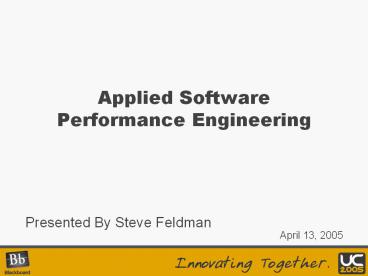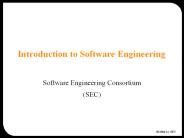Applied Software Performance Engineering - PowerPoint PPT Presentation
Title:
Applied Software Performance Engineering
Description:
Thinking about Performance Early in the Lifecycle. Results/Outcomes ... Eloquence Comes through Iterations. Identify Optimal Performance Patterns ... – PowerPoint PPT presentation
Number of Views:223
Avg rating:3.0/5.0
Title: Applied Software Performance Engineering
1
Applied Software Performance Engineering
- Presented By Steve Feldman
April 13, 2005
2
Welcome
- Session Objectives
- Introduction to Software Performance Engineering
- Understanding the SPE Methodology
- Applying SPE to Building Block Development
- Performance Analysis Tools
- Innovation
- Thinking about Performance Early in the Lifecycle
- Results/Outcomes
- A new approach to design and development
3
Introduction About Your Presenter
- What do I do at Blackboard?
- Director, Software Performance Engineering and
Architecture - Part of Product Development, but interface with
every department in Blackboard. - A few key points
- Been at Blackboard since the Fall of 2003.
- Worked on AP2, AP3 and R7.0
- Manage a team of (4) developer/engineers.
4
Introduction to SPE
- Q What is software performance?
- A Any characteristic of a software product that
you could quantifiably measure? - Q Why is software performance important?
- A The world we live in today is becoming more
digitally sophisticated. We expect our digital
transactions to be faster then our paper
transactions. - Q How do we manage performance in the SDLC?
- A Plan, Predict, Prove, Improve performance
throughout the SDLC?
5
Introduction to SPE
SPE Methodology
Data Collection Usage Analysis
Complete End to End Performance Engineering
Modeling, Profiling and Simulation
End to End Performance Testing
Refactoring and Optimizing
Strategy, Methodology and Best Practices
6
Introduction to SPE
- Performance is at the top of everyones mind.
- If Performance is poor, software adoption will
decline and potentially cause usage attrition or
adoption of alternative products/processes. - Performance Failures cost institutions a large
amount of unplanned money. - Performance problems can create a huge trust
barrier between user and provider of technology. - So then what is SPE?
7
Introduction to SPE
- SPE is a methodology that
- Provides a systematic, quantitative approach to
constructing software systems that meet
performance objectives. - Provides a software-oriented approach to
architecture, design and implementation choices. - Prescribes principles and performance patterns
for creating responsive software. - Performance antipatterns for recognizing and
correcting common problems, the data required for
evaluation, procedures for obtaining performance
specifications, and guidelines for the types of
evaluation to be conducted at each development
stage.
8
Introduction to SPE
- SPE is a Seven Step Methodology focused primarily
on solving the software performance model. - The software performance model consists of
optimizing the design patterns and implementation
of the underlying code for the greatest
performance impact. - Identifying and refactoring software
anti-patterns for performance gain. - Included in this methodology is an understanding
in solving the system performance model. - The system performance model consists of
optimizing the configuration and deployment
options of a system in order to yield the
greatest performance impact without software
modifications. - Making the user experience (response time) more
optimal.
9
Understanding the SPE Methodology
Assess Performance Risk
Establish Performance Objectives
- Assessing the performance risk at the outset of
the project (During Requirements) - Identify, qualify and mitigate
- Specify the quantitative criteria for evaluating
the performance characteristics of the system
under development.
Identify Critical Use Cases
Construct Performance Models
- Look for use cases where there is a risk that,
if performance goals are not met, the system will
fail or be less than successful - Critical actions important to responsiveness as
seen by the user
- Modeling techniques for representing the
software processing steps for the performance
model.
Select Key Performance Scenarios
Determine Software Resource Requirements
- Most frequently executed scenarios, or those
that are critical to the perceived performance of
the system. - Each performance scenario corresponds to a
workload.
- Determination of software resource utilization
(business logic execution) to appropriately
measure effect of software as it scales in usage. - Identification of Performance Anti-Patterns
targeted for refactoring.
Determine System Resource Requirements
- Determination of system resource requirements
utilized by the software under a given workload. - Used for sizing and capacity models.
SPE Methodology, Dr. Connie Smith and Dr. Lloyd
Williams
10
SPE Assessing Risk
- Distinguish between new development and
refactoring. - Work with requirements specialists to understand
the problem/domain issues for the development. - Understand potential inter- versus intra-system
integration. - Apply common sense and basic business logic from
past experiences and similar development projects.
11
SPE Identify Critical Use Cases
- Most important operations/actions in the feature
or system to be developed. - Responsiveness driven.
- Risk driven.
- You look for use cases where there is a risk
that, if performance goals are not met, the
system will fail or be less than successful.
12
SPE Select Key Performance Scenarios
- Unlikely that all critical use cases will be
important to performance. - The key performance scenarios are those that are
executed frequently, or those that are critical
to the perceived performance of the system. - Each performance scenario corresponds to a
workload. - Performance scenarios represented through
sequence diagrams augmented with some useful
extensions.
13
SPE Establish Performance Objectives
- Identify and define performance objectives.
- Specify the quantitative criteria for evaluating
the performance characteristics of the system
under development. - Response time, throughput, or constraints on
resource usage - Identify and define workload objectives.
- Specify the level of usage for the scenario.
- They are specified as an arrival rate (e.g.,
number of Web site hits per hour), number of
concurrent users or number of parallel
transactions.
14
SPE Performance Modeling
- Use of Execution Graphs to represent software
processing steps in the performance model. - The sequence diagram representations of the key
performance scenarios are translated into
execution graphs. - Reverse Engineer ? Reverse Engineer ? Reverse
Engineer
15
SPE Determine Software Resource Requirements
- Understand at an atomic level the types of
software resource requirements. - Method Calls
- SQL Executions
- Data Loading
- Caching
- Understand the effects of this software to inter-
and intra-system components. - Understand at best- and worst-case perspective.
- 90 of the time
- Peak time.
16
SPE Resource Requirements
- Apply Workload Understanding
- Based on findings in the software resource
requirements phase you should be able to
understand at an atomic level... - CPU Cycles consumed by the method call and/or sql
operation. - Network overhead (packet transfer)
- Memory requirements
- Processing Thread/DB Connection Requirements
17
Applying SPE to Blackboard Building Block
Development Software Performance Requirements
- Whats the intended audience of the function?
- Whats the frequency of use of the function?
- How many touch points (integration)?
- What is the function doing?
- Processing/Transacting?
- Navigating?
- Calculating?
- Loading?
- How much data is the function working with?
- Whats the integrity of the transaction?
- Candidate for asynchronous processing?
- Whats the response time expectation of the user?
- Whats the resource requirements to perform the
function?
18
Applying SPE to Blackboard Building Block
Development Software Design
- Data Model
- Size (number of entity types in the model)
- Growth/Capacity (volume driven by usage)
- Complexity (relationships, opacity of values)
- Input/Validation (internationalized, user
provided) - Statistics impact (data that affects the stats
schema) - Data Access
- Frequency (page-level, session-level, cacheable)
- Volatility (same parameters?)
- Volume (Small, medium, large datasets? Entity
size?) - Complexity (Number of joins? Outer joins?)
- File System
- Traceability
- Requirements
- Verification/Testability
- Workflow (s)
- Breadth. Number of discrete paths.
- Depth. How many steps are in each path or branch?
- Complexity. Average number of branches.
- Testability
- Encapsulation. How does a requirements
specification point map to a unit test? - Coverage. What function points cant reasonably
be tested at the unit test level? - Instrumentation. Can the design accommodate
instrumentation to help testing? - Function Points/Unit Tests
19
Applying SPE to Blackboard Building Block
Development Iterative Software Development
- Software Development is an Iterative Process
- Develop for Functionality
- Focus on agility
- Eloquence Comes through Iterations
- Identify Optimal Performance Patterns
- Eliminate Unnecessary Performance Anti-Patterns
- Profile and Instrument
- Refactor Based Findings
20
Applying SPE to Blackboard Building Block
Development Iterative Software Development
- Software Development is an Iterative Process
- Be willing to scrap your development efforts
between iterations. - Focus on simplicity
- Complexity comes from a lack of understanding of
what it is you are designing or developing. - Decompose your development efforts into
manageable components
21
Applying SPE to Blackboard Building Block
Development Iterative Software Development
Concept Summary
Empirical Defined specific, quantitative, measurable performance objectives for performance scenarios.
Instrumentation Instrument systems as you build them to enable measurement and analysis of workload scenarios, resource requirements, and performance objective compliance.
Centering Identify the dominant workload functions and minimize their processing.
Location Create actions, functions and results that are close to physical computer resources.
Processing versus Frequency Minimize the product of processing times frequency.
Distribution of Resources Share resources when possible. When exclusive access is required, minimize the sum of the holding time plus the scheduling time.
Streamlining Execute processing in parallel (only) when the processing speedup offsets the communication overhead and resource contention delays.
Distribution of Processing Spread the load when possible by processing conflicting loads at different times or in different places.
22
Applying SPE to Blackboard Building Block
Development Iterative Software Development
- A pattern is a common solution to a problem that
occurs in many different contexts. - Patterns capture knowledge about best practices
in software design for reuse and application. - Antipatterns are similar to design patterns in
that they document recurring solutions to common
design problems. - Antipatterns produce negative consequences.
- Antipatterns document common mistakes made during
software development.
23
Performance Analysis Tools
- Tools for Different Purposes
- Modeling/Diagramming
- Entity Relationships, Activity and Deployment
- Developing
- IDE (Eclipse)
- Textual Editing
- Load Generation
- Grinder, Apache JMeter and Volano
- Loadrunner, Segue
- Profiling
- Application Layer
- JProbe, Performasure, OptimizeIt, Wily
Enterprise, HPJmeter - Database Layer
- Hotsos, IronEye, Built-in Blackboard Profiling
24
Thank You For Participating
- Innovating Together in 05
- Performance is at the top of everyones mind.
- Design for Performance
- Develop for Performance
- Pattern Identification
- Antipattern Identification
- Profile/Instrument
- Resources Available
- www.cmg.org
- www.perfeng.com
- www.acm.org
- Follow up Contact(s)
- Steve Feldman (sfeldman_at_blackboard.com)
- IF YOU ONLY REMEMBER 1 THING
- Performance should not be an afterthought, but an
upfront effort.































